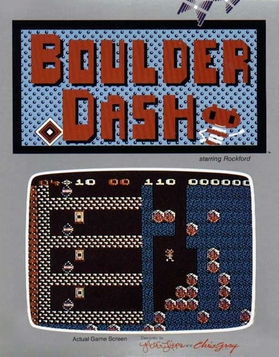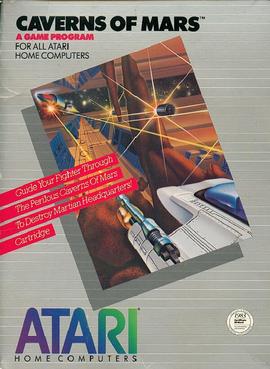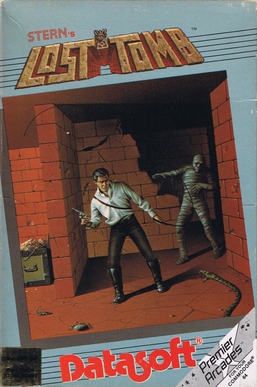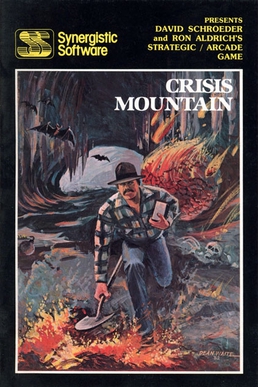
Archon: The Light and the Dark is a 1983 video game developed by Free Fall Associates and one of the first five games published by Electronic Arts. It is superficially similar to chess, in that it takes place on a board with alternating black and white squares, but instead of fixed rules when landing on another player's piece, an arcade-style fight takes place to determine the victor, and each piece has different combat abilities. The health of the player's piece is enhanced when landing on a square of one's own color.

Joust is an action game developed by Williams Electronics and released in arcades in 1982. While not the first two-player cooperative video game, Joust's success and polished implementation popularized the concept. Players assume the role of knights armed with lances and mounted on large birds, who must fly around the screen and defeat enemy knights riding buzzards.

Pitfall! is a video game developed by David Crane for the Atari 2600 and released in 1982 by Activision. The player controls Pitfall Harry, who has a time limit of 20 minutes to seek treasure in a jungle. The game world is populated by enemies and hazards that variously cause the player to lose lives or points.

Boulder Dash is a 2D maze-puzzle video game released in 1984 by First Star Software for Atari 8-bit computers. It was created by Canadian developers Peter Liepa and Chris Gray. The player controls Rockford, who collects treasures while evading hazards.

Lode Runner is a 2D puzzle-platform game, developed by Doug Smith and published by Broderbund in 1983. Its gameplay mechanics are similar to Space Panic from 1980. The player controls a character who must collect all the gold pieces in a level and get to the end while being chased by a number of enemies. It is one of the first games to include a level editor.

The Sentinel, released in the United States as The Sentry, is a puzzle video game created by Geoff Crammond, published by Firebird in 1986 for the BBC Micro and converted to the Commodore 64, Amstrad CPC, ZX Spectrum, Atari ST, Amiga and IBM PC compatibles. The Sentinel was among the first games to use solid-filled 3D graphics on home computers. It won numerous awards upon release and has since appeared on several "best video games of all time" lists.

H.E.R.O. is a video game designed by John Van Ryzin and published by Activision for the Atari 2600 in March 1984. It was ported to the Apple II, Atari 5200, Atari 8-bit computers, ColecoVision, Commodore 64, MSX, and ZX Spectrum.

Montezuma's Revenge is a 1984 platform game for Atari 8-bit family, Atari 2600, Atari 5200, Apple II, ColecoVision, Commodore 64, IBM PC, and ZX Spectrum. It was designed and programmed by Robert Jaeger and published by Parker Brothers. The game's title references a colloquial expression for diarrhea contracted while visiting Mexico.

Pitfall II: Lost Caverns is a video game developed by David Crane for the Atari 2600. It was released in 1984 by Activision. The player controls Pitfall Harry, who must explore in wilds of Peru to find the Raj Diamond, and rescue his niece Rhonda and their animal friend Quickclaw. The game world is populated by enemies and hazards that variously cause the player to lose points and return to a checkpoint.

DuckTales: The Quest for Gold is a platform game developed by Incredible Technologies for the Amiga, Commodore 64, Atari ST and MS-DOS. It was published in 1990 by Walt Disney Computer Software. The game bears little resemblance to the Capcom game known simply as DuckTales that was released for the NES and Game Boy.

Caverns of Mars is a vertically scrolling shooter for Atari 8-bit computers. It was written by Greg Christensen, with some features later added by Richard Watts, and published by the Atari Program Exchange (APX) in 1981. Caverns of Mars became the best selling APX software of all-time and was moved into Atari, Inc.'s official product line, first on diskette, then on cartridge.

Gemstone Warrior is a video game written by Canadian developer Paradigm Creators for the Apple II and published by Strategic Simulations in 1984. It is a 2D action-adventure game where the player controls an armored figure searching for treasure and the pieces of the stolen Gemstone. Gemstone Warrior was SSI's first game to sell over 50,000 copies in North America.

Aztec Challenge refers to either of two early action video games published by Cosmi, as well as two subsequent remakes. In all game versions the player takes control of a running Aztec warrior. The first was a side-scrolling platform-jumping game created by Robert Tegel Bonifacio and released in 1982 for Atari 8-bit computers. Subsequently, a different game with the same title and overall theme was created by Paul Norman and released for the Commodore 64. It includes a level in a modified-first-person 3D-style.

Tutankham is a 1982 arcade video game developed and released by Konami and released by Stern in North America. Named after the Egyptian pharaoh Tutankhamun, the game combines a maze shoot 'em up with light puzzle-solving elements. It debuted at the European ATE and IMA amusement shows in January 1982, before releasing worldwide in Summer 1982. The game was a critical and commercial success and was ported to home systems by Parker Brothers.

Paul Norman is an American game designer, musician, composer, and computer programmer. He has been active in the music scene since 1970 and has been involved with the development of computer entertainment and information since 1982, including the production of Forbidden Forest in 1983.

Yogi's Great Escape is a 1990 platform game based on the 1987 movie of the same name. It was developed by British studio PAL Developments and published by Hi-Tec Software as a budget game. It was released in Europe for Amiga, Amstrad CPC, Atari ST, Commodore 64, Atari 8bit and ZX Spectrum.

The Pharaoh's Curse is a platform adventure game written by Steve Coleman and published by Synapse Software in 1983 for Atari 8-bit computers. It was ported to the Commodore 64 and VIC-20, with the VIC version published by Human Engineered Software. Coleman also wrote Rainbow Walker for Synapse, published the same year.

Lost Tomb is an overhead-view twin-stick shooter written by Dan Lee and released as an arcade video game by Stern Electronics in 1982. Armed with a gun and whip, the player uses dual joysticks to explore the chambers of a South American pyramid looking for treasure and fighting mummies, spiders, and scorpions. The game was Stern's first arcade conversion kit and was intended for use with earlier machines from the company.

Crisis Mountain is a platform game written by David H. Schroeder for the Apple II and published by Synergistic Software in 1982. A port to Atari 8-bit computers was released in 1983. Creative Software published cartridge versions for the Commodore 64 and VIC-20. Ports for the FM-7 and PC-8800 series were from Comptiq.

O'Riley's Mine is an action game designed by Mark Riley and published in 1983 by Datasoft for Atari 8-bit computers. The game was ported to the Apple II by Larry Lewis and Commodore 64 by Al Rubin. Both ports were also released in 1983.





















